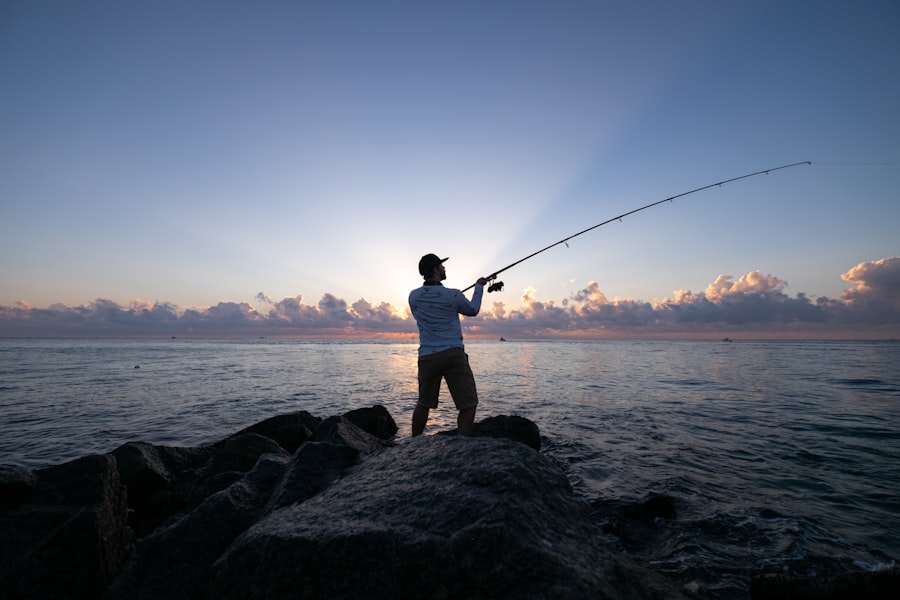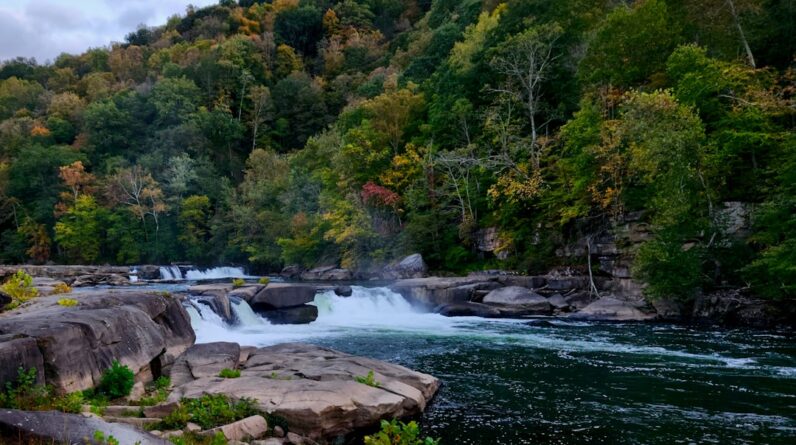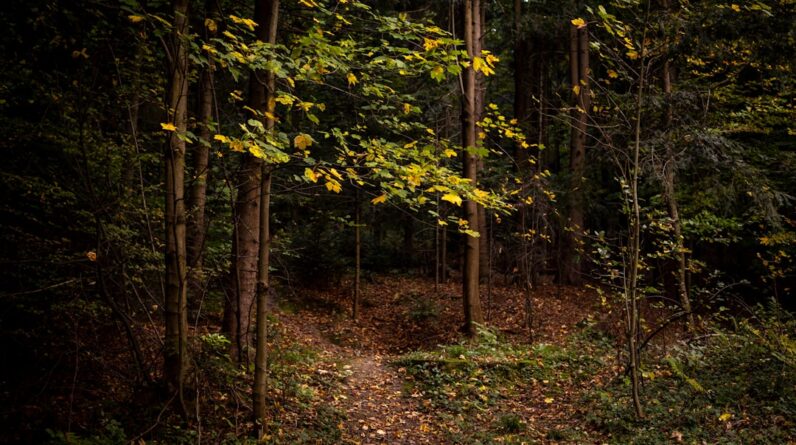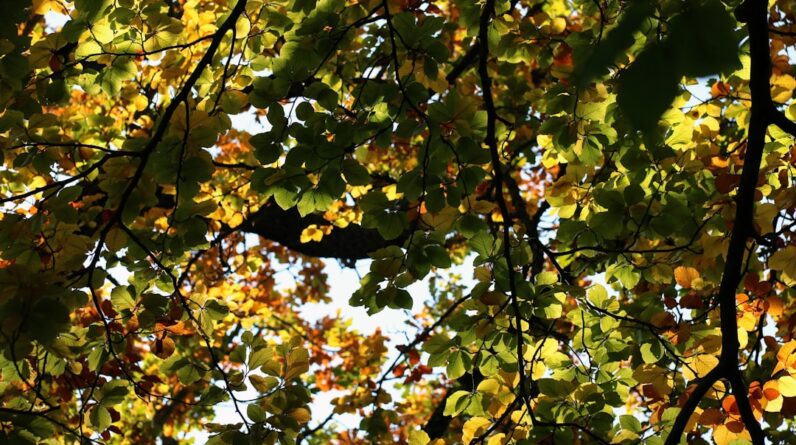Ontario, Canada is known for its vast and beautiful bodies of water, making it a prime destination for fishing enthusiasts. With over 250,000 lakes and countless rivers and streams, Ontario offers a wide range of fishing opportunities for anglers of all skill levels. The fishing industry in Ontario is a significant part of the province’s economy, attracting both locals and tourists alike. Whether you’re looking to catch trophy-sized fish or simply enjoy the tranquility of being out on the water, Ontario’s waters have something to offer everyone.
Fishing in Ontario is not just about catching fish; it’s about the excitement and joy that comes with being out in nature. The anticipation of feeling a tug on your line, the thrill of reeling in a big catch, and the satisfaction of spending time in the great outdoors are all part of the experience. Whether you’re fishing from a boat, casting from shore, or fly fishing in a river, there is something magical about being surrounded by nature and immersing yourself in the sport of fishing.
Key Takeaways
- Ontario offers thrilling fishing experiences for anglers
- A guide is available to help find the best fishing spots in Ontario
- Ontario’s fishing holes have legends and myths surrounding them
- A comprehensive list of the top 10 fishing lakes in Ontario is available
- Ontario’s rivers and streams are a hidden gem for anglers
Finding the Best Fishing Spots in Ontario: A Guide for Anglers
Finding the best fishing spots in Ontario can be a daunting task, especially if you’re new to the area. However, with a little research and some insider tips, you can increase your chances of finding success on the water. One of the best resources for anglers is the Ontario Ministry of Natural Resources and Forestry (MNRF) website. They provide detailed information on fishing regulations, stocking programs, and even interactive maps that show the locations of popular fishing spots.
Another great resource for anglers is local fishing guides and outfitters. These professionals have extensive knowledge of the area and can provide valuable insights into where to find the best fishing spots. They can also offer advice on what types of bait or lures to use, as well as techniques for catching different species of fish. Additionally, joining online fishing forums or social media groups can connect you with other anglers who can share their experiences and recommendations for fishing spots in Ontario.
The Legends and Lore of Ontario’s Fishing Holes: Stories and Myths
Ontario’s fishing holes are not just known for their abundance of fish; they also have a rich history of legends and lore. Many of these stories have been passed down through generations and have become part of the cultural fabric of the province. One such legend is the story of “Old Ned,” a mythical giant fish that is said to inhabit Lake Nipissing. According to the tale, Old Ned is so large that he can swallow a man whole, and many fishermen claim to have seen him lurking beneath the surface.
Another famous fishing spot with its own legend is Eagle Lake. It is said that the lake got its name from an encounter between a young boy and an eagle. The boy was fishing on the lake when an eagle swooped down and stole his catch. In retaliation, the boy threw his fishing line at the eagle, which became tangled in its talons. The eagle flew away, dragging the boy behind it until they both disappeared into the lake. Since then, it is believed that the spirits of the boy and the eagle still reside in Eagle Lake.
These stories and myths add an element of mystery and excitement to Ontario’s fishing holes, making them even more enticing for anglers. Whether you believe in these legends or not, they are a testament to the cultural significance of fishing in Ontario and the deep connection that people have with these waters.
The Top 10 Fishing Lakes in Ontario: A Comprehensive List
Ontario is home to countless lakes, but some stand out as premier fishing destinations due to their abundance of fish species and scenic beauty. Here is a comprehensive list of the top 10 fishing lakes in Ontario:
1. Lake Nipissing: Known for its trophy-sized muskie and walleye, Lake Nipissing is a popular destination for anglers looking for a challenge. The lake also offers excellent fishing for bass, pike, and panfish.
2. Lake of the Woods: Located in Northwestern Ontario, Lake of the Woods is famous for its diverse fishery, including walleye, muskie, bass, and northern pike. With over 14,000 islands and 65,000 miles of shoreline, this lake offers endless opportunities for exploration.
3. Georgian Bay: Part of Lake Huron, Georgian Bay is known for its stunning scenery and excellent fishing. Anglers can target a variety of species, including salmon, trout, bass, and pike.
4. Lake Simcoe: Located just north of Toronto, Lake Simcoe is a popular destination for ice fishing in the winter months. The lake is home to a variety of fish species, including perch, whitefish, lake trout, and smallmouth bass.
5. Lake Superior: As the largest freshwater lake in the world by surface area, Lake Superior offers unparalleled fishing opportunities. Anglers can target salmon, trout, walleye, and whitefish in this vast and beautiful lake.
6. Lake Erie: Known for its world-class walleye fishing, Lake Erie is a must-visit destination for anglers. The lake also offers excellent fishing for bass, perch, and steelhead.
7. Lake St. Clair: Situated between Lake Huron and Lake Erie, Lake St. Clair is famous for its muskie fishing. Anglers can also target bass, walleye, and yellow perch in this productive lake.
8. Lac Seul: Located in Northwestern Ontario, Lac Seul is known for its trophy-sized walleye and northern pike. The lake also offers excellent fishing for muskie, smallmouth bass, and perch.
9. Lake Temagami: With its crystal-clear waters and pristine wilderness, Lake Temagami is a paradise for anglers. The lake is home to a variety of fish species, including lake trout, walleye, smallmouth bass, and whitefish.
10. Lake Huron: As one of the Great Lakes, Lake Huron offers exceptional fishing opportunities. Anglers can target salmon, trout, walleye, and bass in this vast and diverse lake.
Each of these lakes has its own unique characteristics and fishing opportunities, making them all worth exploring for anglers looking to experience the best of Ontario’s fishing.
Exploring Ontario’s Rivers and Streams: A Hidden Gem for Anglers
While Ontario’s lakes often steal the spotlight when it comes to fishing, the province’s rivers and streams are a hidden gem for anglers. These flowing bodies of water offer a different fishing experience and can be home to a variety of fish species. Whether you’re fly fishing for trout in a remote river or casting for smallmouth bass in a local stream, Ontario’s rivers and streams provide endless opportunities for anglers.
One of the benefits of fishing in rivers and streams is the ability to cover more ground. Unlike lakes, which can be vast and overwhelming, rivers and streams are more manageable in size. This allows anglers to explore different sections of the waterway and target specific areas where fish are likely to be hiding. Additionally, rivers and streams often have faster-moving water, which can create ideal conditions for certain fish species.
When fishing in rivers and streams, it’s important to pay attention to the current and structure of the water. Fish tend to congregate near rocks, fallen trees, or other underwater structures that provide cover from the current. By targeting these areas with your bait or lure, you increase your chances of catching fish. It’s also important to be mindful of the regulations for each specific river or stream, as some may have restrictions on fishing methods or catch limits.
The Best Time to Fish in Ontario: Tips and Tricks for Planning Your Trip

The best time to fish in Ontario depends on the species you’re targeting and the time of year. Generally, spring and fall are considered prime fishing seasons in Ontario, as the water temperatures are ideal for many fish species. However, each season offers its own unique opportunities and challenges for anglers.
In the spring, as the ice melts and the water begins to warm up, fish become more active and start moving closer to shore. This is a great time to target species like walleye, pike, and bass, as they are often found in shallower water during this time. Spring is also a popular time for steelhead fishing in Ontario’s rivers, as these migratory fish make their way upstream to spawn.
Summer can be a challenging time for fishing in Ontario, as the warmer water temperatures can cause fish to become less active. However, early mornings and evenings can still provide good fishing opportunities, especially for species like bass and panfish. It’s also worth noting that summer is a great time for fly fishing in Ontario’s rivers, as insect hatches are abundant and fish are actively feeding on the surface.
Fall is widely regarded as one of the best times to fish in Ontario. As the water cools down, fish become more active and start feeding heavily in preparation for winter. This is a prime time to target species like walleye, muskie, and salmon, as they are often found in deeper water during this time. Fall is also a popular time for trophy-sized fish, as many species are at their largest before spawning.
When planning your fishing trip to Ontario, it’s important to consider the weather conditions and pack accordingly. Dressing in layers is recommended, as the weather can change quickly, especially in the spring and fall. It’s also a good idea to check the weather forecast before heading out on the water, as strong winds or storms can make fishing difficult or unsafe.
In terms of equipment, it’s important to have the right gear for the type of fishing you’ll be doing. This includes rods, reels, lines, and tackle specific to the species you’re targeting. It’s also a good idea to bring a variety of bait or lures, as fish can be finicky and may prefer one type over another. Finally, don’t forget to pack sunscreen, bug spray, and plenty of snacks and water to keep you comfortable and hydrated throughout the day.
Understanding Ontario’s Fishing Regulations: What You Need to Know
Before heading out on your fishing adventure in Ontario, it’s important to familiarize yourself with the province’s fishing regulations. These regulations are in place to protect fish populations and ensure sustainable fishing practices. Violating these regulations can result in fines or other penalties, so it’s crucial to know the rules before you cast your line.
The Ontario Ministry of Natural Resources and Forestry (MNRF) is responsible for managing the province’s fisheries and enforcing fishing regulations. They provide a comprehensive guidebook that outlines all the rules and regulations for recreational fishing in Ontario. This guidebook covers topics such as fishing seasons, catch limits, size restrictions, and gear restrictions.
One of the most important regulations for anglers in Ontario is the requirement to have a valid fishing license. Fishing licenses can be purchased online through the MNRF website or at various retail outlets throughout the province. The cost of a fishing license varies depending on factors such as residency status, duration of the license, and whether you plan to fish in designated conservation areas.
In addition to having a valid fishing license, anglers must also adhere to catch limits and size restrictions for each species of fish. These limits are in place to ensure that fish populations remain healthy and sustainable. It’s important to note that catch limits and size restrictions can vary depending on the specific body of water you’re fishing in, so it’s crucial to consult the fishing regulations guidebook or the MNRF website for up-to-date information.
Another important regulation to be aware of is the use of certain fishing gear. For example, some lakes or rivers may have restrictions on the use of live bait or barbed hooks. It’s important to check the regulations for each specific body of water before using any fishing gear. Additionally, there may be specific rules regarding the transportation and possession of fish, so it’s important to familiarize yourself with these regulations as well.
By understanding and following Ontario’s fishing regulations, anglers can help protect fish populations and ensure that future generations can enjoy the thrill of fishing in Ontario’s waters.
The Science of Fishing: Understanding Fish Behavior and Habitat
Fishing is not just a matter of luck; it’s also a science. Understanding fish behavior and habitat can greatly increase your chances of catching fish. Fish are complex creatures with unique behaviors and preferences, and by learning more about them, you can become a more successful angler.
One of the key factors in successful fishing is understanding where fish are likely to be found. Fish are influenced by a variety of factors, including water temperature, oxygen levels, food availability, and underwater structures. By targeting areas where these factors align, you increase your chances of finding fish.
For example, many species of fish prefer to stay near underwater structures such as rocks, fallen trees, or weed beds. These structures provide cover from predators and create areas where food is likely to be abundant. By casting your bait or lure near these structures, you increase your chances of attracting fish.
Water temperature is another important factor to consider when fishing. Different species of fish have different temperature preferences, and they will often move to areas where the water temperature is most comfortable for them. For example, in the summer months, fish may move to deeper, cooler water to escape the heat. By understanding these temperature preferences, you can target areas where fish are likely to be congregating.
Fish behavior is also influenced by the time of day. Many species of fish are more active during certain times of day, such as early morning or evening. This is often when they are feeding and more likely to bite. By timing your fishing trips to coincide with these periods of increased activity, you can increase your chances of catching fish.
In addition to understanding fish behavior and habitat, it’s also important to have the right equipment and techniques for the type of fishing you’ll be doing. Different species of fish require different types of bait or lures, and using the wrong one can greatly reduce your chances of success. It’s also important to use the right fishing line and hooks for the size and strength of the fish you’re targeting.
By combining knowledge of fish behavior and habitat with the right equipment and techniques, you can become a more successful angler and increase your enjoyment of the sport.
The Role of Conservation in Ontario’s Fishing Industry: Protecting the Environment
Conservation plays a crucial role in Ontario’s fishing industry. The province’s vast and diverse bodies of water are home to a wide range of fish species, many of which are highly valued by anglers. However, overfishing and habitat destruction can threaten these populations, making conservation efforts essential for sustaining the fishing industry in Ontario. Conservation measures such as catch limits, size restrictions, and seasonal closures help to ensure that fish populations have the opportunity to reproduce and replenish their numbers. Additionally, efforts to protect and restore aquatic habitats, such as wetlands and spawning grounds, are crucial for maintaining healthy fish populations. By implementing these conservation practices, Ontario’s fishing industry can continue to thrive while also preserving the natural environment for future generations.
Check out this related article on Travelogs.org: “The Transition Journey: Managing Menopause with Ease.” Menopause can be a challenging time for many women, but this article provides helpful tips and insights on how to navigate this stage of life with ease. From understanding the physical and emotional changes to finding natural remedies for managing symptoms, this article offers valuable information for women going through menopause. Read more








